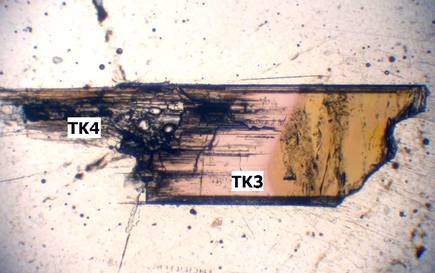Crystal structures, chemical (including light
elements) and spectral data (optical and
Mössbauer spectroscopies) were
used to characterize coloured (brown, pink, green) tourmalines from
three granitic
pegmatites from the Moldanubian nappes (Königsalm, Maigen and
Blocherleitengraben;
Lower Austria).
The tourmalines can be classified as fluor-schorl, schorl, foitite, magnesiofoitite,
olenite and “fluor-elbaite”
with varying Li contents, up to ~1.2 wt.% Li2O. Coexisting
minerals are quartz, plagioclase (up
to 7 mol% anorthite), microcline, garnet (spessartine-almandine),
muscovite,
biotite (annite), very rare lepidolite, apatite, monazite-(Ce),
xenotime-(Y),
allanite-(Ce) and zircon.
The chemical composition of the Fe2+-rich
tourmaline samples (up to
~1.0 wt.% TiO2) varies from fluor-schorl, with a = 15.987(2), c
=
7.163(2) Å to X(˙0.63Na0.37) Y(Fe2+1.12Al1.09Mg0.56Mn2+0.08Fe3+0.07Li0.02Ti4+0.01Zn0.01˙0.04) Z(Al5.74Mg0.26)
(BO3)3 [Si5.96Al0.04O18]
V(OH)3
W[(OH)0.95F0.05],
strongly dichroic (pink and blue) foitite, with a
= 15.9537(2), c =
7.1448(4) Å, to X(˙0.51Na0.49) Y(Fe2+0.97Al0.93Mg0.75Fe3+0.23Mn2+0.04Li0.01Ti4+0.01˙0.06) Z(Al5.72Mg0.28)
(BO3)3 [Si5.95Al0.05O18]
V(OH)3
W[(OH)0.91O0.06F0.03],
magnesiofoitite, with a =
15.9476(4),
c = 7.1578(4) Å. The
chemical composition
of the Al- and Li-rich and Mn2+-bearing (up to
~5.7 wt.% MnO)
samples varies from X(Na0.84Ca0.02˙0.14) Y(Al1.35Li0.78Mn2+0.65Ti4+0.01˙0.21) ZAl6
(BO3)3 [Si5.92Al0.04B0.04O18]
V(OH)3
W[F0.81(OH)0.19],
“fluor-elbaite” with a
= 15.8887(3), c = 7.1202(3)
Å, to X(Na0.76Ca0.12˙0.12) Y(Al1.52Li0.69Mn2+0.43Fe2+0.09˙0.27) ZAl6
(BO3)3 [Si5.71B0.29O18]
V(OH)3
W[F0.69(OH)0.31],
B-rich “fluor-elbaite”, with a
=
15.8430(3), c = 7.1051(3)
Å. A positive
correlation between the <T-O>
and <Z-O> bond lengths
in
tourmalines where the Z site is
only
occupied by Al (R2
= 0.617)
is useful to correct the <Z-O>
bond length for the inductive effect of the varying <T-O> bond length. This is
important for producing accurate
assignments for the different 6-coordinated sites in tourmaline.
On the basis of Sm-Nd (garnet,
monazite), U-Th-Pb, and U-Pb ages (monazite), the pegmatites
crystallized during
the Variscan tectonometamorphic event in the Visean (339 ± 4 Ma Maigen, 332 ± 3 Ma
Königsalm). These ages
are in the range of the earliest intrusions of the South Bohemian
pluton
(Rastenberg type durbachites). However, on the basis of the spatial
relationship of the pegmatites and the Rastenberg type intrusions, a
linkage of
the intrusive body and the pegmatites is unlikely. Alternatively, the
pegmatites may have evolved as granitic pegmatitic melts during decompression from
the surrounding country rocks
in the frame of exhumation of the Modanubic nappes after the peak of
the Variscan
metamorphism.
------------------

